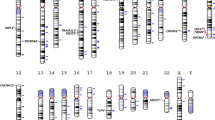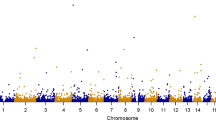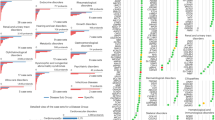Abstract
Using restriction fragment length polymorphism and pyrosequencing methods, we genotyped two TNFA gene promoter SNPs (−G308A, −G238A) and analyzed the haplotype structure in 24 Canadian families of primarily Celtic origin. Our results demonstrate that after correction for multiple testing based on simulations of 10 000 replicates of unlinked/unassociated data, there is evidence for association (P=0.026) of a specific haplotype (−308A, −238G) with schizophrenia and schizophrenia spectrum disorders with a family-based trimmed haplotype linkage disequilibrium test (Trimhap). Stratifying the 22 families with genome scan data by TNFA promoter haplotypes followed by reanalysis of linkage to schizophrenia throughout the genome, we identified few loci that exhibit a considerable increase in LOD/HLOD scores. A locus on chromosome 1q44 (D1S1609) demonstrated a significant increase (P=0.025) in LOD score from 0.15 to 3.01 with a broad definition of the schizophrenia phenotype and a dominant mode of inheritance. This result replicates a previously reported positive result of linkage of schizophrenia spectrum disorders to this area of the genome. We also illustrated that simulation studies are pivotal in evaluating the significance of results obtained with newer statistical methods, when multiple, but not independent, tests are performed, and when sample stratification is utilized to reduce the impact of heterogeneity or assess the interaction between loci.
This is a preview of subscription content, access via your institution
Access options
Subscribe to this journal
Receive 12 print issues and online access
$259.00 per year
only $21.58 per issue
Buy this article
- Purchase on Springer Link
- Instant access to full article PDF
Prices may be subject to local taxes which are calculated during checkout
Similar content being viewed by others
References
McGuffin P, Asherson P, Owen M, Farmer A . The strength of the genetic effect. Is there room for an environmental influence in the aetiology of schizophrenia. Br J Psychiatry 1994; 164: 593–599.
Bassett AS, Chow EWC, Waterworth DM, Brzustowicz L . Genetic insights into schizophrenia. Canad J Psychiatry 2001; 46: 131–137.
Lewis CM, Levinson DF, Wise LH, DeLisi LE, Straub RE, Hovatta I et al. Genome scan meta-analysis of schizophrenia and bipolar disorder. Part II: Schizophrenia. Am J Hum Genet 2003; 73: 34–48.
Bassett AS, Chow EW, Weksberg R, Brzustowicz L . Schizophrenia and genetics: new insights. Curr Psychiatry Rep 2002; 4: 307–314.
Lander E, Kruglyak L . Genetic dissection of complex traits: guidelines for interpreting and reporting linkage results. Nat Genet 1995; 11: 241–247.
Brzustowicz LM, Hodgkinson KA, Chow EW, Honer WG, Bassett AS . Location of a major susceptibility locus for familial schizophrenia on chromosome 1q21–q22. Science 2000; 288: 678–682.
Blouin J-L, Dombroski BA, Nath SK, Lasseter VK, Wolyniec PS, Nestadt G et al. Schizophrenia susceptibility loci on chromosomes 13q32 and 8p21. Nat Genet 1998; 20: 70–73.
Bassett AS, Chow EW, O’Neill S, Brzustowicz LM . Genetic insights into the neurodevelopmental hypothesis of schizophrenia. Schizophr Bull 2001; 27: 417–430.
Wright P, Nimgaonkar VL, Donaldson PT, Murray RM . Schizophrenia and HLA: a review. Schizophr Res 2001; 47: 1–12.
Moises HW, Yang L, Kristbjarnarson H, Wiese C, Byerley W, Macciardi F et al. An international two-stage genome-wide search for schizophrenia susceptibility genes. Nat Genet 1995; 11: 321–324.
Schwab SG, Albus M, Hallmayer J, Honig S, Borrmann M, Lichtermann D et al. Evaluation of a susceptibility gene for schizophrenia on chromosome 6p by multipoint affected sib-pair linkage analysis. Nat Genet 1995; 11: 325–327.
Straub RE, MacLean CJ, O’Neill FA, Burke J, Murphy B, Duke F et al. A potential vulnerability locus for schizophrenia on chromosome 6p24–22: evidence for genetic heterogeneity. Nat Genet 1995; 11: 287–293.
Maziade M, Bissonnette L, Rouillard E, Martinez M, Turgeon M, Charron L et al. 6p24–22 region and major psychoses in the Eastern Quebec population. Le Groupe IREP. Am J Med Genet 1997; 74: 311–318.
Riley BP, Williamson R . Non-parametric analysis of chromosome 6p24–22 marker data and schizophrenia in southern African Bantu-speaking families. Psychiatr Genet 1997; 7: 131–132.
Arolt V, Lencer R, Nolte A, Muller-Myhsok B, Purmann S, Schurmann M et al. Eye tracking dysfunction is a putative phenotypic susceptibility marker of schizophrenia and maps to a locus on chromosome 6p in families with multiple occurrence of the disease. Am J Med Genet 1996; 67: 564–579.
Brzustowicz LM, Honer WG, Chow EW, Hogan J, Hodgkinson K, Bassett AS . Use of a quantitative trait to map a locus associated with severity of positive symptoms in familial schizophrenia to chromosome 6p. Am J Hum Genet 1997; 61: 1388–1396.
Hashimoto L, Habita C, Beressi JP, Delepine M, Besse C, Cambon-Thomsen A et al. Genetic mapping of a susceptibility locus for insulin-dependent diabetes mellitus on chromosome 11q. Nature 1994; 371: 161–164.
Davies JL, Kawaguchi Y, Bennett ST, Copeman JB, Cordell HJ, Pritchard LE et al. A genome-wide search for human type 1 diabetes susceptibility genes. Nature 1994; 371: 130–136.
Luo DF, Buzzetti R, Rotter JI, Maclaren NK, Raffel LJ, Nistico L et al. Confirmation of three susceptibility genes to insulin-dependent diabetes mellitus: IDDM4, IDDM5 and IDDM8. Hum Mol Genet 1996; 5: 693–698.
Nakagawa Y, Kawaguchi Y, Twells RC, Muxworthy C, Hunter KM, Wilson A et al. Fine mapping of the diabetes-susceptibility locus, IDDM4, on chromosome 11q13. Am J Hum Genet 1998; 63: 547–556.
Eckenrode S, Marron MP, Nicholls R, Yang MC, Yang JJ, Guida Fonseca LC et al. Fine-mapping of the type 1 diabetes locus (IDDM4) on chromosome 11q and evaluation of two candidate genes (FADD and GALN) by affected sibpair and linkage-disequilibrium analyses. Hum Genet 2000; 106: 14–18.
Hajeer AH, Hutchinson IV . Influence of TNF[alpha] gene polymorphisms on TNF[alpha] production and disease. Hum Immunol 2001; 62: 1191–1199.
Selvaraj P, Sriram U, Kurian SM, Reetha AM, Narayanan PR . Tumour necrosis factor alpha (−238 and −308) and beta gene polymorphisms in pulmonary tuberculosis: haplotype analysis with HLA-A, B and DR genes. Tuberculosis 2001; 81: 335–341.
Boin F, Zanardini R, Pioli R, Altamura CA, Maes M, Gennarelli M . Association between −G308A tumor necrosis factor alpha gene polymorphism and schizophrenia. Mol Psychiatry 2001; 6: 79–82.
Schwab SG, Mondabon S, Knapp M, Albus M, Hallmayer J, Borrmann-Hassenbach M et al. Association of tumor necrosis factor alpha gene −G308A polymorphism with schizophrenia. Schizophr Res 2003; 65: 19–25.
Rothermundt M, Arolt V, Bayer TA . Review of immunological and immunopathological findings in schizophrenia. Brain Behav Immun 2001; 15: 319–339.
Ekelund J, Hovatta I, Parker A, Paunio T, Varilo T, Martin R et al. Chromosome 1 loci in Finnish schizophrenia families. Hum Mol Genet 2001; 10: 1611–1617.
Brzustowicz LM, Simone J, Mohseni P, Hayter JE, Hodgkinson KA, Chow EWC et al. Linkage disequilibrium mapping of schizophrenia susceptibility to the CAPON region of chromosome 1q22. Am J Hum Genet 2004; 74: 1057–1063.
Bassett AS, Collins EJ, Nuttall SE, Honer WG . Positive and negative symptoms in families with schizophrenia. Schizophr Res 1993; 11: 9–19.
Bassett AS, Honer WG . Evidence for anticipation in schizophrenia. Am J Hum Genet 1994; 54: 864–870.
Day IN, Humphries SE . Electrophoresis for genotyping: microtiter array diagonal gel electrophoresis on horizontal polyacrylamide gels, hydrolink, or agarose. Anal Biochem 1994; 222: 389–395.
Ronaghi M, Uhlen M, Nyren P . A sequencing method based on real-time pyrophosphate. Science 1998; 281: 363–365.
Ahmadian A, Gharizadeh B, Gustafsson AC, Sterky F, Nyren P, Uhlen M et al. Single-nucleotide polymorphism analysis by pyrosequencing. Anal Biochem 2000; 280: 103–110.
Mitchell AA, Cutler DJ, Chakravarti A . Undetected genotyping errors cause apparent overtransmission of common alleles in the transmission/disequilibrium test. Am J Hum Genet 2003; 72: 598–610.
O’Connell JR, Weeks DE . PedCheck: a program for identification of genotype incompatibilities in linkage analysis. Am J Hum Genet 1998; 63: 259–266.
Sobel E, Lange K . Descent graphs in pedigree analysis: applications to haplotyping, location scores, and marker-sharing statistics. Am J Hum Genet 1996; 58: 1323–1337.
Sobel E, Sengul H, Weeks DE . Multipoint estimation of identity-by-descent probabilities at arbitrary positions among marker loci on general pedigrees. Hum Hered 2001; 52: 121–131.
Sobel E, Papp JC, Lange K . Detection and integration of genotyping errors in statistical genetics. Am J Hum Genet 2002; 70: 496–508.
MacLean CJ, Martin RB, Sham PC, Wang H, Straub RE, Kendler KS . The trimmed-haplotype test for linkage disequilibrium. Am J Hum Genet 2000; 66: 1062–1075.
Terwilliger JD, Speer M, Ott J . Chromosome-based method for rapid computer simulation in human genetic linkage analysis. Genet Epidemiol 1993; 10: 217–224.
Terwilliger JD, Ott J . Handbook of Human Genetic Linkage. Johns Hopkins University Press: Baltimore, 1994.
O’Connell JR, Weeks DE . The VITESSE algorithm for rapid exact multilocus linkage analysis via genotype set-recoding and fuzzy inheritance. Nat Genet 1995; 11: 402–408.
Ott J . Linkage probability and its approximate confidence interval under possible heterogeneity. Genet Epidemiol Suppl 1986; 1: 251–257.
Brzustowicz LM, Hayter JE, Hodgkinson KA, Chow EWC, Bassett AS . Fine mapping of the schizophrenia susceptibility locus on chromosome 1q22. Hum Hered 2002; 54: 199–209.
Muller N . Immunological and infectious aspects of schizophrenia. Eur Arch Psychiatry Clin Neurosci 2004; 254: 1–3.
Hinze-Selch D, Pollmacher T . In vitro cytokine secretion in individuals with schizophrenia: results, confounding factors, and implications for further research. Brain Behav Immun 2001; 15: 282–318.
Muller N, Ulmschneider M, Scheppach C, Schwarz MJ, Ackenheil M, Moller HJ et al. COX-2 inhibition as a treatment approach in schizophrenia: immunological considerations and clinical effects of celecoxib add-on therapy. Eur Arch Psychiatry Clin Neurosci 2004; 254: 14–22.
Muller N, Riedel M, Scheppach C, Brandstatter B, Sokullu S, Krampe K et al. Beneficial antipsychotic effects of celecoxib add-on therapy compared to risperidone alone in schizophrenia. Am J Psychiatry 2002; 159: 1029–1034.
Wei J, Hemmings GP . The NOTCH4 locus is associated with susceptibility to schizophrenia. Nat Genet 2000; 25: 376–377.
Skol AD, Young KA, Tsuang DW, Faraone SV, Haverstock SL, Bingham S et al. Modest evidence for linkage and possible confirmation of association between NOTCH4 and schizophrenia in a large veterans affairs cooperative study sample. Am J Med Genet 2003; 118B: 8–15.
Anttila S, Kampman O, Illi A, Roivas M, Mattila KM, Lassila V et al. NOTCH4 gene promoter polymorphism is associated with the age of onset in schizophrenia. Psychiatr Genet 2003; 13: 61–64.
Luo X, Klempan TA, Lappalainen J, Rosenheck RA, Charney DS, Erdos J et al. NOTCH4 gene haplotype is associated with schizophrenia in African Americans. Biol Psychiatry 2004; 55: 112–117.
Wei J, Hemmings GP . TNXB locus may be a candidate gene predisposing to schizophrenia. Am J Med Genet 2004; 125B: 43–49.
Wright P, Donaldson PT, Underhill JA, Choudhuri K, Doherty DG, Murray RM . Genetic association of the HLA DRB1 gene locus on chromosome 6p21.3 with schizophrenia. Am J Psychiatry 1996; 153: 1530–1533.
Arinami T, Otsuka Y, Hamaguchi H, Itokawa M, Aoki J, Shibuya H et al. Evidence supporting an association between the DRB1 gene and schizophrenia in Japanese. Schizophr Res 1998; 32: 81–86.
Akaho R, Matsushita I, Narita K, Okazaki Y, Okabe Y, Matsushita M et al. Support for an association between HLA-DR1 and schizophrenia in the Japanese population. Am J Med Genet 2000; 96: 725–727.
Li T, Underhill J, Liu XH, Sham PC, Donaldson P, Murray RM et al. Transmission disequilibrium analysis of HLA class II DRB1, DQA1, DQB1 and DPB1 polymorphisms in schizophrenia using family trios from a Han Chinese population. Schizophr Res 2001; 49: 73–78.
Nimgaonkar VL, Ganguli R, Rudert WA, Vavassori C, Rabin BS, Trucco M . A negative association of schizophrenia with an allele of the HLA DQB1 gene among African-Americans. Schizophr Res 1993; 8: 199–209.
Nimgaonkar VL, Rudert WA, Zhang XR, Tsoi WF, Trucco M, Saha N . Further evidence for an association between schizophrenia and the HLA DQB1 gene locus. Schizophr Res 1995; 18: 43–49.
Nimgaonkar VL, Rudert WA, Zhang X, Trucco M, Ganguli R . Negative association of schizophrenia with HLA DQB1*0602: evidence from a second African-American cohort. Schizophr Res 1997; 23: 81–86.
Naudin J, Capo C, Giusano B, Mege JL, Azorin JM . A differential role for interleukin-6 and tumor necrosis factor-alpha in schizophrenia? Schizophr Res 1997; 26: 227–233.
Monteleone P, Fabrazzo M, Tortorella A, Maj M . Plasma levels of interleukin-6 and tumor necrosis factor alpha in chronic schizophrenia: effects of clozapine treatment. Psychiatry Res 1997; 71: 11–17.
Kowalski J, Blada P, Kucia K, Madej A, Herman ZS . Neuroleptics normalize increased release of interleukin-1 beta and tumor necrosis factor-alpha from monocytes in schizophrenia. Schizophr Res 2001; 50: 169–175.
Erbagci AB, Herken H, Koyluoglu O, Yilmaz N, Tarakcioglu M . Serum IL-1beta, sIL-2R, IL-6, IL-8 and TNF-alpha in schizophrenic patients, relation with symptomatology and responsiveness to risperidone treatment. Mediators Inflamm 2001; 10: 109–115.
Hashimoto R, Yoshida M, Ozaki N, Yamanouchi Y, Iwata N, Suzuki T et al. Association analysis of the −308G >A promoter polymorphism of the tumor necrosis factor alpha (TNF-alpha) gene in Japanese patients with schizophrenia. J Neur Transm 2004; 111: 217–221.
Tan EC, Chong SA, Tan CH, Teo YY, Peng K, Mahendran R . Tumor necrosis factor-alpha gene promoter polymorphisms in chronic schizophrenia. Biol Psychiatry 2003; 54: 1205–1211.
Tsai SJ, Hong CJ, Yu YW, Lin CH, Liu LL . No association of tumor necrosis factor alpha gene polymorphisms with schizophrenia or response to clozapine. Schizophr Res 2003; 65: 27–32.
Pae CU, Chae JH, Bahk WM, Han H, Jun TY, Kim KS et al. Tumor necrosis factor-alpha gene polymorphism at position −308 and schizophrenia in the Korean population. Psychiatry Clin Neurosci 2003; 57: 399–403.
Handoko HY, Nancarrow DJ, Hayward NK, Ohaeri JU, Aghanwa H, McGrath JJ et al. Tumor necrosis factor haplotype analysis amongst schizophrenia probands from four distinct populations in the Asia-Pacific region. Am J Med Genet 2003; 121B: 1–6.
Beattie EC, Stellwagen D, Morishita W, Bresnahan JC, Ha BK, Von Zastrow M et al. Control of synaptic strength by glial TNFalpha. Science 2002; 295: 2282–2285.
Takahashi JL, Giuliani F, Power C, Imai Y, Yong VW . Interleukin-1beta promotes oligodendrocyte death through glutamate excitotoxicity. Ann Neurol 2003; 53: 588–595.
Harrison PJ, Owen MJ . Genes for schizophrenia? Recent findings and their pathophysiological implications. Lancet 2003; 361: 417–419.
Sawa A, Snyder SH . Schizophrenia: neural mechanisms for novel therapies. Mol Med 2003; 9: 3–9.
Blackwood DH, Fordyce A, Walker MT, St Clair DM, Porteous DJ, Muir WJ . Schizophrenia and affective disorders—cosegregation with a translocation at chromosome 1q42 that directly disrupts brain-expressed genes: clinical and P300 findings in a family. Am J Hum Genet 2001; 69: 428–433.
Hovatta I, Varilo T, Suvisaari J, Terwilliger JD, Ollikainen V, Arajarvi R et al. A genomewide screen for schizophrenia genes in an isolated Finnish subpopulation, suggesting multiple susceptibility loci. Am J Hum Genet 1999; 65: 1114–1124.
Ekelund J, Lichtermann D, Hovatta I, Ellonen P, Suvisaari J, Terwilliger JD et al. Genome-wide scan for schizophrenia in the Finnish population: evidence for a locus on chromosome 7q22. Hum Mol Genet 2000; 9: 1049–1057.
Acknowledgements
This work was supported by grant R01 MH62440 from the National Institutes of Mental Health (LMB), the Canadian Institutes of Health Research (ASB), and The Bill Jefferies Schizophrenia Endowment Fund (ASB). Genotyping services were provided by the Center for Inherited Disease Research (CIDR). CIDR is fully funded through contract N01-HG-65403 from the National Institutes of Health to The Johns Hopkins University.
Author information
Authors and Affiliations
Corresponding author
Additional information
Electronic-Database Information
Center for Inherited Disease Research (CIDR), http://www.cidr.jhmi.edu/ (for genotyping protocols)Online Mendelian Inheritance in Man (OMIM), http://www.ncbi.nlm.nih.gov/Omim/.Pyrosequencing Technical Support, http://techsupport.pyrosequencing.com (for Pyrosequencing SNP Primer Design Software v 1.0.)UCSC Genome Browser, http://genome.cse.ucsc.edu/ (for July 2003 NCBI Build 34 of the human genome)Whitehead Institute, http://www.genome.wi.mit.edu/genome-software/other/primer3.html (for PRIMER3)
Rights and permissions
About this article
Cite this article
Saviouk, V., Chow, E., Bassett, A. et al. Tumor necrosis factor promoter haplotype associated with schizophrenia reveals a linked locus on 1q44. Mol Psychiatry 10, 375–383 (2005). https://doi.org/10.1038/sj.mp.4001582
Received:
Revised:
Accepted:
Published:
Issue Date:
DOI: https://doi.org/10.1038/sj.mp.4001582
Keywords
This article is cited by
-
Pro-inflammatory cytokines and their epistatic interactions in genetic susceptibility to schizophrenia
Journal of Neuroinflammation (2016)
-
Decreased serum TNF-alpha levels in chronic schizophrenia patients on long-term antipsychotics: correlation with psychopathology and cognition
Psychopharmacology (2015)
-
The nuclear factor-κB inhibitor pyrrolidine dithiocarbamate reduces polyinosinic-polycytidilic acid-induced immune response in pregnant rats and the behavioral defects of their adult offspring
Behavioral and Brain Functions (2011)
-
Evidence for HTR1A and LHPP as interacting genetic risk factors in major depression
Molecular Psychiatry (2009)
-
An association study of ADSS gene polymorphisms with schizophrenia
Behavioral and Brain Functions (2008)



